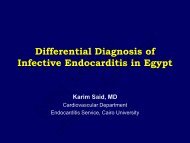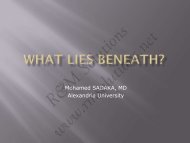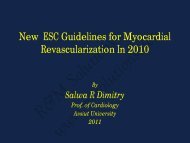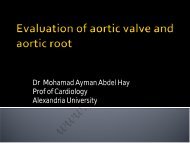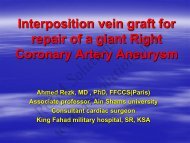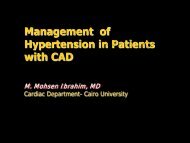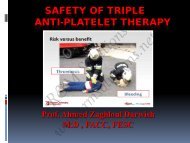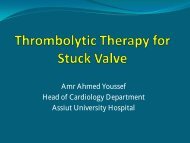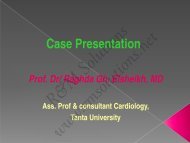RM Solutions - cardioegypt2011
RM Solutions - cardioegypt2011
RM Solutions - cardioegypt2011
Create successful ePaper yourself
Turn your PDF publications into a flip-book with our unique Google optimized e-Paper software.
10/25/2011<br />
Highlights<br />
CT/CMR/Nuclear Imaging<br />
CardioEgypt 2011<br />
Islam Shawky A‐Aziz, Aziz, MD<br />
Al‐Azhar University<br />
Evaluation of Coronary Artery<br />
Plaque Vulnerability using PET/CT<br />
<strong>RM</strong> <strong>Solutions</strong><br />
Hossam Sherif, MD<br />
Assistant Professor of Critical Care Medicine<br />
Cairo University<br />
ESC 2011, Sharm Al Shiekh<br />
1
10/25/2011<br />
Cardiac CT Scan<br />
Is the most effective method for detecting calcifications in<br />
the plaque.<br />
The atheroma has to be advanced enough to have large<br />
areas of calcification (> 2 mm 2 ) that the scanner software<br />
can recognize.<br />
Such regions start occurring within the heart arteries<br />
about 2–3 decades after atheroma starts developing.<br />
The absence of calcifications does not necessarily imply<br />
the absence of vulnerable plaque.<br />
Cardiac PET/CT<br />
Wykrzykowska J. JNM, 2009<br />
With spatial resolution > 5 mm in the new PET scanners,<br />
further evaluation of cardiovascular imaging:<br />
g<br />
<strong>RM</strong> <strong>Solutions</strong><br />
- Characterization of Coronary Artery Plaque (CAP)<br />
Vulnerability using co-registration with CT,<br />
- Discrimination between subendocardial and<br />
subepicardial blood flow,<br />
- Imaging of different cardiac reporter gene expression.<br />
Bravo PE. J Cardiovasc Transl Res, 2011<br />
2
10/25/2011<br />
Conclusions<br />
18 F-FDG PET/CT imaging g is poised to play a potentially<br />
important role by providing information on the biology of<br />
atherosclerotic lesions, thereby complementing the only<br />
structural information that can be derived from other<br />
imaging technologies.<br />
Such biological assessment of atherosclerotic plaques may<br />
evolve into a clinical application as a risk assessment tool<br />
for cardiovascular disease, and may facilitate the<br />
evaluation of anti-atherosclerotic drugs.<br />
<strong>RM</strong> <strong>Solutions</strong><br />
3
10/25/2011<br />
Dr. Adel Allam, MD,FASNC<br />
Professor of Cardiology, Al Azhar University<br />
Atherosclerosis<br />
Flow limiting stenosis<br />
Yes or No<br />
Yes or No<br />
Calcium scoring<br />
Doppler flow wire<br />
CT Angiography<br />
g Stress imaging<br />
g<br />
<strong>RM</strong> <strong>Solutions</strong><br />
0% 30% 50% > 70% > 90%<br />
4
10/25/2011<br />
Normal MPI scan in 58 y old male<br />
patient.<br />
C.T coronaries of the same<br />
patient showing no calcification<br />
<strong>RM</strong> <strong>Solutions</strong><br />
Normal MPI scan in 60 y<br />
old patient.<br />
LAD of the same patient<br />
showing heavy CAC.<br />
5
10/25/2011<br />
DISTRIBUTION OF CORONARY CALCIUM SCORES<br />
50.00%<br />
45.00%<br />
40.00%<br />
35.00%<br />
30.00%<br />
49.4%<br />
<strong>RM</strong> <strong>Solutions</strong><br />
25.00%<br />
20.00%<br />
15.00%<br />
10.00%<br />
5.00%<br />
20.8%<br />
16.1%<br />
8.9%<br />
13.7%<br />
4.8%<br />
0.00%<br />
0 1-10 11-100 > 101-400 > 400<br />
6
10/25/2011<br />
We concluded that the majority of Egyptians patients with negativee<br />
myocardial perfusion imaging have low CAC score.<br />
Although still 13.7% of the patients has CAC score > 100.<br />
And the predictors of significant CAC score would include age, gender, risk<br />
factors particularly (diabetes mellitus, hypertension and smoking) .<br />
<strong>RM</strong> <strong>Solutions</strong><br />
7
10/25/2011<br />
<strong>RM</strong> <strong>Solutions</strong><br />
‣ Cardiac resynchronization therapy (CRT) is<br />
approved for the treatment of patients with<br />
advanced heart failure (HF) symptoms.<br />
‣ LVEF < 35 and wide QRS (> 120 ms)<br />
8
10/25/2011<br />
‣ Patient in HF NYHA Class III or IV<br />
‣ LVEF < 35%<br />
‣ LV dyssynchronous<br />
QRS > 130 ms (electrically).<br />
Mechanically (accurately and reproducibly).<br />
‣ Is lateral wall infarcted<br />
Usual placement for 3rd lead.<br />
Bleeker et al, Circulation 2006; 113:969-976.<br />
<strong>RM</strong> <strong>Solutions</strong><br />
Class III Heart Failure<br />
LVEF (Echo) = 32%<br />
Class III Heart Failure<br />
LVEF (Echo) = 27%<br />
9
10/25/2011<br />
Gated SPECT imaging has the ability to quantify LV<br />
dyssynchrony, myocardial perfusion and LV function.<br />
Dyssynchrony data as measured by the quantitative<br />
phase analysis indices (PSD + PHB) and myocardial<br />
perfusion and function data may improve the<br />
discriminative ability of GSPECT imaging for selection of<br />
patients for CRT.<br />
<strong>RM</strong> <strong>Solutions</strong><br />
10
10/25/2011<br />
Radionuclide Imaging in Heart<br />
Failure<br />
Dr. Mohamed Farid, MD.<br />
Prof. of Cardiology, Faculty<br />
of Medicine,<br />
Al Azhar University.<br />
<br />
• <br />
<br />
<strong>RM</strong> <strong>Solutions</strong><br />
• <br />
• <br />
• <br />
• <br />
11
10/25/2011<br />
Myocardial perfusion imaging in the<br />
acute care setting<br />
Does it still have a role<br />
<strong>RM</strong> <strong>Solutions</strong><br />
Prof Dr/Sahar Azab ,MD<br />
Prof Of Cardiology , Alexandria<br />
12
10/25/2011<br />
Conclusions<br />
‣Acute MPI remains an important technology<br />
that t can identify the few high‐risk h ikpatients<br />
t<br />
among those with a low‐risk presentation.<br />
‣Appropriate utilization can reduce costs while<br />
improving outcomes.<br />
‣ In spite of newer, evolving tecnologies,<br />
acute MPI continue to have a significant role<br />
in the acute evaluation of ED chest pain<br />
<strong>RM</strong> <strong>Solutions</strong><br />
13
10/25/2011<br />
Borderline (intermediate)<br />
coronary plaques<br />
Magdy Rashwan, MD<br />
Professor of cardiology<br />
University of Alexandria<br />
Egypt<br />
An intermediate borderline coronary<br />
lesion is defined on angiography as a<br />
luminal narrowing with a diameter<br />
stenosis more than 40% but less than<br />
70%.<br />
<strong>RM</strong> <strong>Solutions</strong><br />
Assessment of a coronary lesion with<br />
intermediate severity continues to be a<br />
challenge for cardiologists.<br />
14
10/25/2011<br />
SOME ANGIOGRAPHICALLY SEVERE<br />
LESIONS ARE NOT ISCHEMIC<br />
SOME ANGIOGRAPHICALLY MILD LESIONS<br />
ARE HEMODYNAMICALLY SIGNIFICANT<br />
<strong>RM</strong> <strong>Solutions</strong><br />
Adenosine<br />
FFR = 50 / 92 = 0.53<br />
“Pseudo‐Mild Stenosis”<br />
15
10/25/2011<br />
SOME ANGIOGRAPHICALLY MILD<br />
LESIONS HEAVILY BURDENED BY PLAQUE<br />
The debate between morphological and<br />
functional approaches is going ever more in<br />
favor of function assessment.<br />
<strong>RM</strong> <strong>Solutions</strong><br />
FFR currently enjoys class IA recommendation<br />
ahead of revascularization<br />
Functional angioplasty<br />
16
10/25/2011<br />
Cardiac Imaging for the<br />
Investigation of Chest Pain:<br />
Which Test is Best<br />
<strong>RM</strong> <strong>Solutions</strong><br />
Dr. R. S. Khattar DM FRCP FACC FESC<br />
Consultant Cardiologist and Honorary Clinical Senior Lecturer<br />
Manchester Royal Infirmary and University of Manchester<br />
17
10/25/2011<br />
NICE Guidelines for Recent Onset<br />
Suspected Cardiac Chest Pain 2010<br />
• Low likelihood of CAD (10-29%)<br />
– CT coronary calcification scores ± CT coronary<br />
angiography<br />
• Intermediate likelihood of CAD (30-60%)<br />
– Stress echo, nuclear imaging, MR, CT<br />
• High Likelihood of CAD (61-90%)<br />
– Invasive coronary angiography or stress echo/nuclear<br />
imaging<br />
Summary<br />
• Use a tailored approach to the investigation of chest pain<br />
based on the patient’s pre-test probability of CAD<br />
<strong>RM</strong> <strong>Solutions</strong><br />
• Exercise ECG may still have a role in patients with low<br />
pre-test probability of CAD<br />
• Stress echo, nuclear imaging, MR or CT for intermediate<br />
pre-test probability group - depends on local expertise<br />
• Ischaemia testing or invasive coronary angiography in<br />
patients with high pre-test probability of CAD<br />
18
10/25/2011<br />
<strong>RM</strong> <strong>Solutions</strong><br />
GAMELA NASR , MD<br />
Professor of Cardiology, Consultant in national<br />
Insurance & Sporting hospitals Cairo<br />
Master of Medical Education Holland-SCU<br />
Diploma of E Teaching NORWAY<br />
19
10/25/2011<br />
<strong>RM</strong> <strong>Solutions</strong><br />
39<br />
40<br />
20
10/25/2011<br />
Echocardiography<br />
• Increase in systolic<br />
contraction at low dose<br />
dobutamine <br />
presence of viable<br />
myocardium<br />
<strong>RM</strong> <strong>Solutions</strong><br />
41<br />
• New regional wall<br />
motion defects, decline<br />
in EF, increase in endsystolic<br />
volume with<br />
stress myocardial<br />
ischemia<br />
21
10/25/2011<br />
MRI Gadolinium‐DTPA<br />
<strong>RM</strong> <strong>Solutions</strong><br />
Conclusions: Visualization of coronary collaterals to the infarct-related<br />
artery by coronary angiography may predict with a high sensitivity but a<br />
low specificity the presence of viability in the territory supplied by that<br />
artery.<br />
22
10/25/2011<br />
<strong>RM</strong> <strong>Solutions</strong><br />
Dr. Ashraf Badawi<br />
MD Cardiology<br />
Ain Shams Faculty of Medicine<br />
23
10/25/2011<br />
• Found in ~0.1%‐1.3% of patients undergoing<br />
cardiac catheterization<br />
• Can be associated with congenital heart disease or<br />
be isolated anomaly<br />
• Invasive angio evaluation can be challenging;<br />
misdiagnosis happens in up to 50% of cases<br />
g pp p 5<br />
• So, although it is rare but it is an important cause of<br />
CP, arrhythmia, MI & sudden cardiac death.<br />
• And also it is TREATABLE<br />
• CT angiography g allows evaluation of not<br />
<strong>RM</strong> <strong>Solutions</strong><br />
just arterial caliber and lumen but also<br />
their origin, course and relationship to<br />
adjacent structures.<br />
24
10/25/2011<br />
• Anomalies of origin and course.<br />
• Absent LM trunk.<br />
<strong>RM</strong> <strong>Solutions</strong><br />
25
10/25/2011<br />
<strong>RM</strong> <strong>Solutions</strong><br />
• Anomalous coronary arteries are rare but<br />
potentially life‐threatening & treatable causes<br />
for CP, MI & sudden cardiac death<br />
• CTA plays vital role in making diagnosis.<br />
• Not difficult to diagnose once familiar with basic<br />
variations on anomalous anatomy and which<br />
are the dangerous variants<br />
26
10/25/2011<br />
<strong>RM</strong> <strong>Solutions</strong><br />
27
10/25/2011<br />
MSCT-CA<br />
Latest<br />
Appropriateness<br />
Criteria<br />
Islam Shawky A-Aziz<br />
Assist. Prof. of Cardiology<br />
Al-Azhar University<br />
<strong>RM</strong> <strong>Solutions</strong><br />
28
10/25/2011<br />
Appropriateness Criteria<br />
2006 2010<br />
• 39 indications<br />
• 13 Appropriate<br />
• 13 Uncertain<br />
• 13 Inappropriate<br />
• 93 indications<br />
• 35 Appropriate<br />
• 29 Uncertain<br />
• 29 Inappropriate<br />
<strong>RM</strong> <strong>Solutions</strong><br />
29
10/25/2011<br />
Finally,<br />
Appropriateness criteria<br />
are not substitutes t for<br />
sound clinical judgment<br />
and practice experience<br />
with each patient and<br />
clinical presentation<br />
<strong>RM</strong> <strong>Solutions</strong><br />
30
10/25/2011<br />
Case presentations<br />
• Dr. Amr Adel<br />
• Dr. Hany Mouris<br />
• Dr. Muhammad Mandour<br />
<strong>RM</strong> <strong>Solutions</strong><br />
رباه النرجو خلودا فديارنا ليست ھنا<br />
وجنات خلدك حلمنا وترابھا وطن لنا<br />
رباه فاجمعنا بھا واجعل اعاليھا لنا<br />
31




